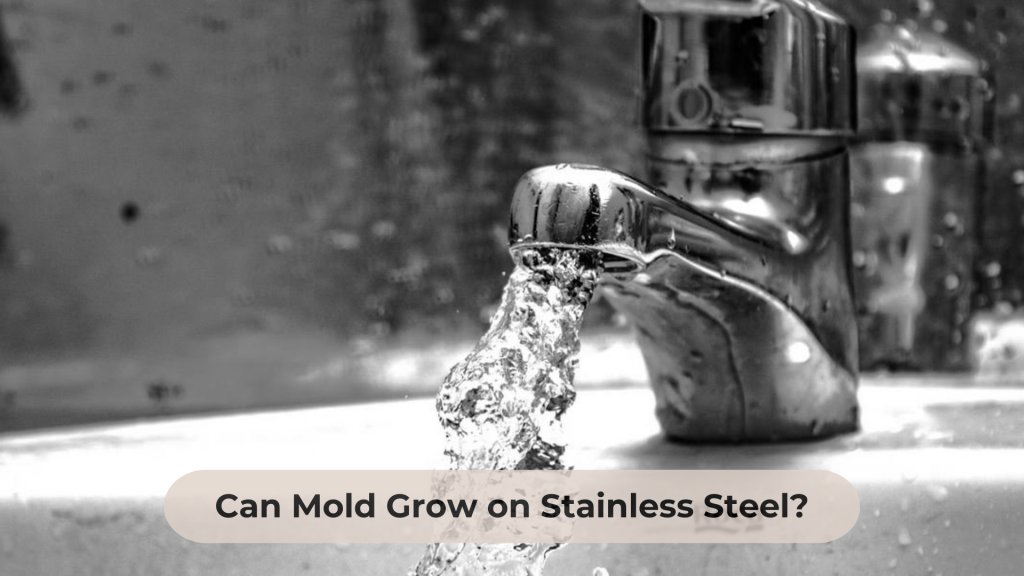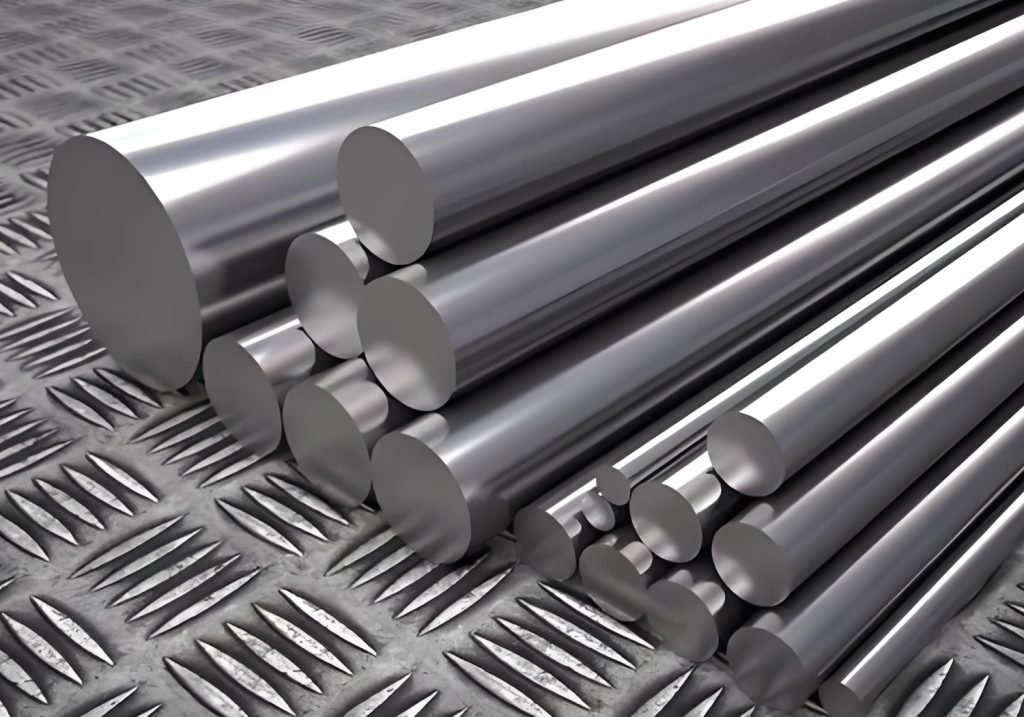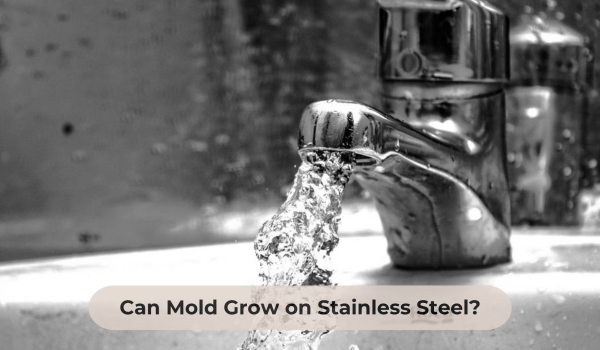Mold growth usually occurs on damp walls together with wooden surfaces and food items yet stainless steel surfaces present different circumstances for mold colonization. The answer requires complete knowledge about both mold characteristics alongside stainless steel characteristics. The scientific fact shows mold does not consume stainless steel directly yet it will persist on stainless steel surfaces subject to certain environmental factors. When stainless steel remains unprotected from moisture and contains organic material while going without regular maintenance it will allow mold growth.

Understanding Mold Growth
Fungus-type mold needs three fundamental requirements to reproduce which include moisture along with organic materials and suitable temperature zones. Stainless steel functions as a non-porous substance unlike wood so it maintains difficulty in holding moisture or absorbing nutrients. Mold forms a thin biofilm on stainless steel surfaces when it comes into contact with humid conditions or when food particles and dust accumulate on these surfaces thus posing contamination threats to industrial processes.
Industries at Risk
The production sector depends substantially on stainless steel components for use in all aspects of mold tooling along with mold manufacturing and mold making operations. Companies that work in this sector prefer using stainless steel due to its durability and resistance to corrosion and low needs in maintenance practices. Stainless steel surfaces develop mold in humid areas or regions where the cleaning protocols are insufficient thus affecting machine performance and creating sanitary problems.
Why Mold Can Appear on Stainless Steel
Stainless steel does not provide favorable conditions for mold growth but external environmental elements lead to its development. Mold needs organic debris present in food processing facilities and kitchens as well as industrial equipment to use as nourishment. Stainless steel surfaces that stay damp over an extended period allow mold spores to settle down and grow.
The situation worsens because of poor ventilation together with inconsistent cleaning protocols. The production of high-precision mold-making parts in mold tooling sectors and mold manufacturing operations remains prone to microbial growth because small mold design features including crevices and cooling channels can harbor moisture accumulation.
Preventing Mold Growth on Stainless Steel
Stainless steel mold prevention requires industrial establishments to follow strict cleaning procedures with adequate environmental control measures. Mold manufacturing units require scheduled regular maintenance above all else since materials exposed to multiple substances in these facilities need preventive measures. Specialized cleaning solutions should be employed to remove natural substances and stop the development of microbial biofilms.
The removal of all residual moisture and organic particles from mold tools becomes vital to prevent mold formation during tool and machinery cleaning procedures. The implementation of controlled storage and operational space humidity and temperature controls significantly decreases the possibility of mold development.
Advanced Solutions in Mold Manufacturing
Mold making and mold manufacturing industries utilize antimicrobial coatings on stainless steel surfaces as an advanced mold prevention method while they develop their operations. The coatings function as an extra safety layer that stops both microbial sticking and their ability to grow.
Mold tooling industries are implementing novel designs that reduce surface crevices to decrease water retention in their products. Stainless steel molds enjoy improved longevity together with higher cleanliness because of these methods.

Cleaning and Maintenance of Stainless Steel Surfaces
Businesses that use stainless steel materials heavily require correct cleaning methods. The recommended method for maintenance uses non-abrasive antimicrobial solutions which need to be applied regularly. Surface drying procedures after washing help eliminate moisture which otherwise triggers mold growth.
To eliminate microbial contamination industrial companies that produce molds and mold making equipment need to use either steam cleaning or chemical sterilization methods. Food industry workers must apply food-grade sanitary solutions for maintaining stainless steel surfaces that are safe from mold contamination.
Role of Mold Tooling in Prevention
Manufacturers in mold tooling apply innovative approaches to decrease the potential for mold formation. Mold design through precision tooling consists of minimal grooved features along with restricted spaces to prevent moisture buildup. Industries are spending their capital to obtain self-cleaning mold surfaces that automate cleaning operations along with enhancing hygiene standards.
Stainless steel mold manufacturing processes use protective coatings to stop microbial growth. The additional safety measure provides industries with both operational efficiency and compliance with strict safety standards.
Impact of Mold Growth on Industry Standards
Regulated industries handling medical devices and food need to remain mold-free on their stainless steel surfaces because noncompliance will occur. Key performance requirements established by regulatory organizations dictate detailed cleaning procedures to block microbial infections. When companies do not follow mandated regulations they risk being penalized through financial fines and production shutdowns and product recalls that cause both business monetary losses and reputation impairment.
Holding both worth and quality standards in the mold manufacturing process demands that stainless steel equipment remains without mold contamination. Enterprise success with competitive standing and regulatory fulfillment comes from their investments in superior cleaning systems and mold-resistant production elements.
Innovative Approaches in Mold Prevention
The development of mold tooling systems has brought about self-disinfecting stainless steel surfaces through recent technological progress. The surfaces integrate nanotechnology together with antimicrobial agents which prevent mold development actively. Mold producers have started adding ultraviolet (UV) sterilization systems within their manufacturing process as a means to destroy microorganisms.
The current focus of mold making innovation centers on developing environment-friendly protective coatings designed to stop microbial colonization without affecting stainless steel stability. The innovative materials find their most useful application in food and pharmaceutical operations because hygiene stands as their crucial requirement.
The Future of Stainless Steel in Mold Manufacturing
Stainless steel continues to be an essential substance that supports mold tooling applications and mold manufacturing and mold making processes. Engineering companies continually advance their cleaning procedures while adding technological solutions to stop mold proliferation. Sustainable antimicrobial innovations create production processes with substantial durability while ensuring excellent hygiene standards.
The most effective solution for mold prevention includes using high-quality stainless steel components along with strict cleaning procedures. The advancements in industry lead to improved solutions which keep stainless steel as a trustworthy and safe material across different applications.

The Science Behind Mold Growth on Stainless Steel
Stainless steel exhibits resistance to rust and corrosion yet it cannot completely resist mold development. Mold spores persist throughout all environmental regions until they find stainless steel surfaces coated with organic materials or dampness that causes them to grow. Mold spores need absorbable nutrients to grow but stainless steel has an impermeable surface which permits attachment only when environmental conditions become favorable. The mold industry including mold makers and mold toolmakers adopt rigorous clean-up procedures because they must stop mold contamination from occurring.
The Role of Cleaning Agents in Mold Prevention
Specialized cleaning agents represent one of the best methods for preventing stainless steel surfaces from becoming infected with mold growth. Industrial cleaning solutions that serve mold manufacturing and mold making industries contain antimicrobial substances which eliminate mold spores to prevent their dissemination. Stainless steel can stay clear of biofilm which enables antimicrobial protection by performing regular maintenance using steam cleaning and chemical substances. The tooling experts recognize how the correct solution choices preserve sanitary conditions in their manufacturing process.
How Mold Impacts Stainless Steel Equipment
Stainless steel equipment containing mold poses serious problems in the fields of food processing along with pharmaceuticals and industrial machinery. Mold spores collecting on surfaces become both sanitary hazards and performance-limiting factors to mold tooling effectiveness as well as mold manufacturing processes. Mold making operations need high precision so any form of contamination becomes the cause of defects which results in financial losses. Business operations use preventive measures because they need to maintain stainless steel surfaces free from microbial buildup along with remaining clean.
Environmental Factors That Encourage Mold Growth
The non-porous texture of stainless steel cannot stop multiple environmental conditions from allowing mold growth. Humidity together with condensation and inadequate ventilation allows mold spores to find thrive and proliferate. Industries distributing mold-making equipment use controlled environments as one of their prevention tactics for these types of risks. Changes in temperature build speed for mold growth through increased transmission rates. The usage of air purification systems combined with dehumidifiers allows companies to control moisture levels as they work toward maintaining clean surfaces.
Future Innovations in Mold Prevention
Advancements in technology are shaping new ways to prevent mold growth on stainless steel. Researchers are developing self-cleaning coatings infused with antimicrobial agents that actively repel mold spores. Industries specializing in mold tooling and mold making are adopting these innovations to enhance equipment longevity and efficiency. Additionally, improved ventilation systems and automated cleaning processes are becoming standard in mold manufacturing, ensuring that surfaces remain resistant to microbial contamination. As these technologies continue to evolve, the risk of mold growth on stainless steel will be significantly reduced.
Conclusion
Stainless steel surfaces normally remain mold-free but the substance actively grows when organic materials combine with moisture availability. The combination of routine maintenance and clean-up operations with improved mold production methods enables industries to stop infections and protect their hygienic requirements. High-precision mold tooling specialists in the mold manufacturing industry proactively implement microbial control solutions to maintain stainless steel as a favorite industrial material for various applications.




